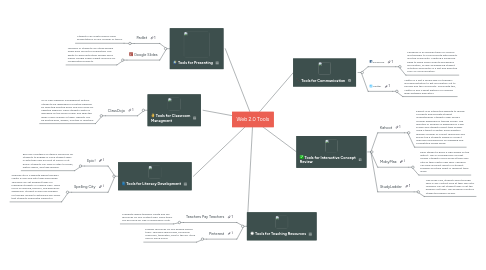
1. Tools for Communication
1.1. Facebook
1.1.1. Facebook is an excellent way for schools and teachers to communicate with parents and the community. Creating a Facebook page to share school events and general information, as well as displaying student activities and photos is a fast and effective form of communication.
1.2. Twitter
1.2.1. Twitter is a fast a simple way for teachers and administration to get information out to families and the community. Along with this, Twitter is also a great platform for sharing ideas between educators.
2. Tools for Interactive Concept Review
2.1. Kahoot
2.1.1. Kahoot is an interactive website to review concepts and evaluate student understanding. Students login using a number displayed on the big screen. The question or problem is displayed on a big screen and students select their answer using a tablet or laptop. Each question displays number of correct responses and places top 5 students based on correct response and speed for an engaging and competitive review game.
2.2. MobyMax
2.2.1. Each student is given a login based on the district. This is a progressive concept review. Students move along at their own rate as they master new skills. Teachers can view and print reports of student progress and time spent in different topic areas.
2.3. StudyLadder
2.3.1. Like Moby Max, students work through skills in any content area at their own rate. Teachers can set student tasks or let the program set tasks. This program monitors students progress as well.
3. Tools for Presenting
3.1. Padlet
3.1.1. Students can create simple visual presentations on any number of topics.
3.2. Google Slides
3.2.1. Teachers or students can utilize google slides easy format for presenting. The ability to share with other google users makes Google Slides a great resource for collaborative projects.
4. Tools for Classroom Managment
4.1. ClassDojo
4.1.1. An in class behavior management system. Students are rewarded for positive behavior by selecting positive dojos and vice versa for negative behavior. Each students avatar is displayed on the home screen and selected when a dojo is given or taken. Reports can be printed daily, weekly, monthly or quarterly.
5. Tools for Literacy Development
5.1. Epic!
5.1.1. Epic has a plethora of literacy resources for students to engage in. Each student signs in with their own account at school or at home. Students can read or listen to books, watch videos, and take quizzes.
5.2. Spelling City
5.2.1. Spelling city is a website where teachers create a class and sets tasks each week. Teachers can set different tasks for individual students or a whole class. Tasks focus on spelling, phonics, and phonemic awareness. Student scores are available for teacher review to determine skill areas that students need extra support in.
6. Tools for Teaching Resources
6.1. Teachers Pay Teachers
6.1.1. A website where teachers create and sell resources for any content area. Many items can be found for free or reasonable costs.
6.2. Pinterest
6.2.1. Endless resources for any desired search topic. Teachers share blogs, classroom resources, templates, links to the TpT store and so much more!

